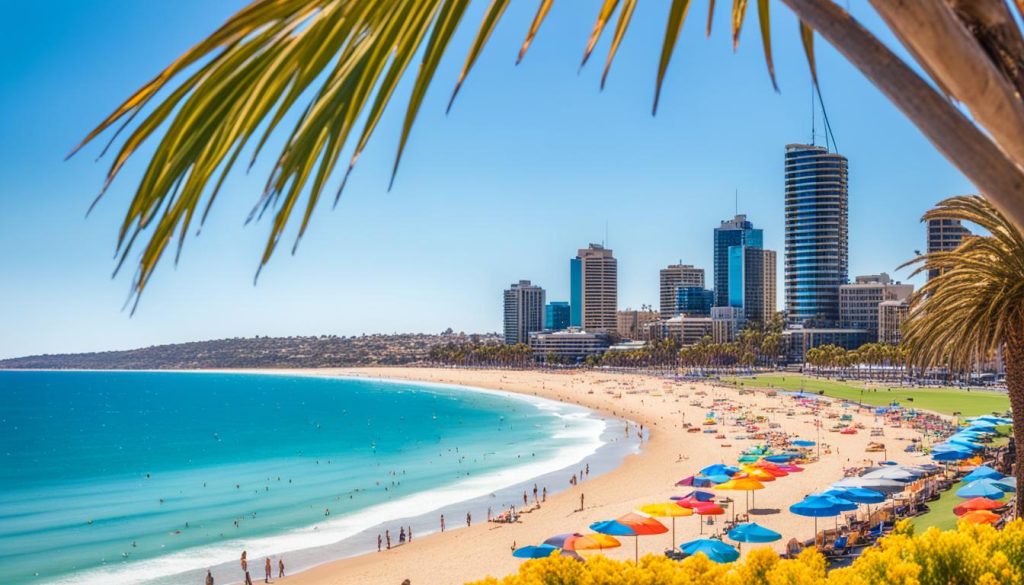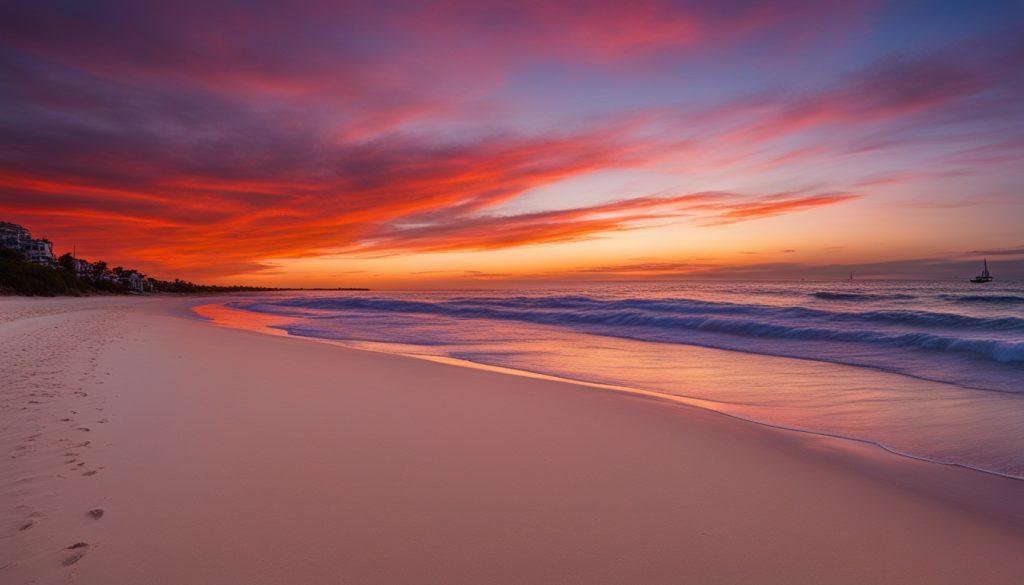Planning a trip to Australia means getting to know its unique climate and seasonal patterns. This country sits in the Southern Hemisphere, so its seasons are opposite to what people in the Northern Hemisphere are used to. So, when is the best time to visit this vast and diverse land? Let’s look into the seasonal changes and find out the best months for your Australian adventure.
Key Takeaways
- Australia’s seasons are the opposite of the Northern Hemisphere, with summer from December to February and winter from June to August.
- The country has a wide range of climates, from the tropical north to the temperate south. There are big differences between the coast and the interior.
- The best time to visit depends on what you want to do, like outdoor activities, cultural events, or avoiding crowds.
- Spring and autumn are often the best seasons, with nice temperatures and fewer people around.
- With careful planning, you can make the most of Australia’s weather and have an unforgettable trip.
Understanding Australia’s Climate Diversity
Australia is in the Southern Hemisphere, so its seasons are opposite to those in the Northern Hemisphere. For instance, while the Northern Hemisphere has summer from June to August, Australia’s warmest months are from December to February. Knowing these seasonal changes is key to planning your trip and enjoying the weather.
Australia’s Location in the Southern Hemisphere
Australia stretches from tropical north to temperate south, offering a wide range of climates. This means the country sees different seasons and temperature changes across its regions. While many think of Australia as warm and dry, the south has its own unique climate.
Contrasting Climates: Coastal vs Interior
The coastal and interior regions of Australia show big differences. The interior is usually hotter and drier than the coast. For example, the center can hit over 100°F (38°C) in summer, while cities like Sydney and Melbourne stay cooler, between 75-78°F (24-26°C).
Some areas, like the Australian Alps in the south, might even get snow in winter. Rainfall also changes a lot across the country. The north, like Cairns and Darwin, has a tropical climate with wet and dry seasons. But the south and center have four seasons, with most rain in the cooler months.
“Australia is a land of weather contrasts, where the sun can scorch the Outback while coastal cities enjoy a more temperate climate. Understanding these regional differences is key to planning a weather-savvy trip.”
If you want sun on the beaches or snow in the mountains, Australia has it all. Learning about the different seasons and climates helps you prepare for your trip. This way, you can enjoy all the amazing things Australia has to offer.
Exploring Adelaide’s Mediterranean-like Climate
Adelaide is in the southern part of Australia and has a Mediterranean-like climate. This climate means visitors can enjoy different weather all year round. From hot summers to mild autumns, the weather is a big reason people visit.
Autumn in Adelaide: March to May
Autumn in Adelaide is a nice break from the summer heat. Temperatures are between 15°C (60°F) and 26°C (80°F). It’s perfect for outdoor activities and cultural events. The Adelaide Fringe, WOMADelaide, and the Adelaide Festival are big events during this time.
Summer in Adelaide: December to February
Summer in Adelaide is great for beach lovers and those who enjoy the outdoors. Temperatures are between 14°C (58°F) and 26°C (78°F). The beaches like Glenelg Beach and Henley Beach are ideal for fun days. You can also experience the city’s Christmas and holiday traditions, including the Adelaide Christmas Pageant.

“Adelaide’s Mediterranean-like climate offers visitors a diverse range of weather experiences throughout the year, from the sun-drenched summer months to the mild and comfortable autumn season.”
| Season | Temperatures | Highlights |
|---|---|---|
| Autumn (March to May) | 15°C (60°F) to 26°C (80°F) |
|
| Summer (December to February) | 14°C (58°F) to 26°C (78°F) |
|
Discovering Perth’s Sunshine City
Perth, the capital of Western Australia, is a city full of sunshine. It has a Mediterranean climate. With an average of 3,200 hours of sunshine each year, it’s one of the sunniest places globally. This makes it known as the “Sunshine City.”
Key Weather Facts
Perth has warm summers and mild winters. This climate is perfect for outdoor fun and enjoying the city’s lively vibe. Summers are warm but not too hot, staying below 90°F (32°C). Winters are mild, ranging from 45°F (7°C) to 65°F (18°C).
Annual Temperature and Precipitation Averages
Perth’s weather is like a Mediterranean paradise all year. February is the hottest month, with temperatures up to 90°F (32°C). The coolest month is July, with temperatures around 46°F (8°C). Rainfall is spread out throughout the year, with the most in July, averaging 3.67 inches.
| Month | Average High (°F) | Average Low (°F) | Average Rainfall (inches) |
|---|---|---|---|
| January | 90 | 63 | 0.02 |
| February | 90 | 64 | 0.07 |
| March | 86 | 61 | 0.07 |
| April | 79 | 56 | 0.33 |
| May | 72 | 51 | 1.75 |
| June | 67 | 48 | 3.08 |
| July | 65 | 46 | 3.67 |
| August | 66 | 46 | 2.68 |
| September | 66 | 48 | 1.73 |
| October | 73 | 50 | 0.59 |
| November | 80 | 56 | 0.31 |
| December | 85 | 59 | 0.06 |
Perth stays mild all year, thanks to the cooling coastal breezes. This keeps the Mediterranean-like weather pleasant.
Summer in Perth: December – February
Perth glows with the Australian summer sun from December to February. This peak season offers long, sunny days ideal for beach fun. The hot sun is tempered by a cool coastal breeze, keeping temperatures pleasant. Daytime highs range from 86°F to 65°F at night.
Summer in Perth is alive with festivals and events. The Perth Festival and Fringe World Festival stand out, showcasing music, theater, dance, and art. These events, along with beach activities, make summer in Perth unforgettable.
| Location | Average High Temp. (Dec – Feb) | Average Low Temp. (Dec – Feb) |
|---|---|---|
| Cairns | 87°F (31°C) | 76°F (24°C) |
| Brisbane | 84°F (29°C) | 70°F (21°C) |
| Sydney | 79°F (26°C) | 68°F (20°C) |
| Melbourne | 78°F (26°C) | 58°F (14°C) |
| Perth | 86°F (30°C) | 65°F (18°C) |
The summer sun in Perth can be strong, so be aware of safety risks like poisonous box jellyfish. With proper planning, you can enjoy the summer and make lasting memories.

Australia: Best Months for a Weather-Savvy Trip
Planning a trip to Australia means looking at its varied climate and weather. The best time to go depends on what you want to do, like enjoying the sun, going on adventures, or exploring culture.
Spring and fall are the best seasons to visit Australia. These times offer pleasant weather and fewer people than the busy summer and winter months.
In Sydney, the weather varies a lot. Temperatures go from 74°F (23°C) in January to 55°F (13°C) in July. June is the wettest month, with 6.4 inches of rain, and December is the windiest, with winds of 12 mph.
February is the best month for swimming in Sydney, with sea temperatures of 75°F (24°C). But, remember, summer can be quite humid, with humidity up to 65%.
Spring and autumn are great for outdoor fun in Sydney. Temperatures range from 75°F (24°C) in November to 53°F (12°C) in September. These seasons are perfect for visiting parks, gardens, and coastal trails.
Cities like Sydney and Melbourne get crowded during holidays and events. But, the outback and remote areas are great all year round. The cooler months are best for outdoor adventures.
The best times to visit Australia depend on what you want to do. Knowing about the seasonal variations and outdoor activities helps plan a trip that fits your interests. This way, you’ll have a trip you’ll always remember.
Autumn in Perth: March – May
As summer ends, Perth welcomes the gentle touch of autumn. From March to May, the weather is just right, with moderate temperatures and fewer crowds. It’s a great time for a trip.
Daytime temperatures range from 72°F (22°C) to 86°F (30°C), ideal for outdoor fun. Nights get cooler, dropping to 51°F (11°C) to 61°F (16°C). This makes evenings perfect for dining outside and taking walks.
With fewer tourists around, perth autumn lets you enjoy the city at your own pace. You can see the beautiful coast and vibrant culture without the crowds.
This season is also great for whale watching. Blue whales and humpback whales come to the perth canyon. It’s a chance to see these huge creatures in their natural setting.

Perth autumn is perfect for a beach vacation, diving into culture, or enjoying nature. With moderate temperatures and fewer crowds, it’s a shoulder season that guarantees a memorable visit.
Winter in Perth: June – August
From June to August, Perth turns into a winter wonderland. The city’s climate stays mild, perfect for exploring. You can enjoy the city and its natural beauty without the cold.
Packing Essentials for Perth’s Winter
For your perth winter trip, pack for mild temperatures. Days are cool, with highs around 65-67°F (18-19°C). Nights get chilly, around 46-48°F (8-9°C). Here are some packing tips:
- A water-resistant or waterproof jacket for rain and storms
- Warm layers like sweaters and thermal underwear for the evenings
- Comfortable shoes or boots for walking around
- An umbrella or rain hat for wet days
- Gloves and a scarf for extra warmth
Even though it’s called “winter,” Perth doesn’t get very cold. So, pack smart with layers that are versatile and comfortable.
“Perth’s winters are truly a delight, with mild temperatures, abundant sunshine, and just the right amount of rainfall to keep the city lush and green.”
Spring in Perth: September – November
As summer warms down and days get longer, Perth turns into a lively spring oasis. From September to November, this “Sunshine City” on Australia’s west coast shines with many natural and cultural spots.
Wildflower Season
Spring in Perth is famous for its wildflower season. Parks like Kings Park are filled with colorful flowers, offering a stunning view. Visitors can explore lush gardens and see the many wildflowers that love the Mediterranean-like weather.
Festivals and Events
Spring brings a full schedule of festivals and events to Perth. These celebrate the city’s culture, art, and community spirit. Some top events include:
- Kings Park Festival: A month-long event celebrating the city’s natural beauty and plants.
- Perth Royal Show: An annual event showing off Western Australia’s farming, animals, and traditions.
- Perth International Jazz Festival: A three-day jazz music event with famous artists from all over.
- Entwined in the Valley: A food and wine festival in the Swan Valley, highlighting local tastes.
As humpback whales move north, they can be seen in Perth’s coastal waters. Spring in Perth is a time of beauty, culture, and memorable moments.
Planning Your Weather-Savvy Trip
Planning your trip to Perth, Australia, means thinking about the weather and seasons. The peak season, from December to January, is summer. It’s busy with events and festivals, but expect higher prices and crowds.
For a quieter visit, try the shoulder seasons of spring and autumn. The weather is nice, and you won’t feel rushed. This lets you explore the city at your own pace.
Best Times for Outdoor Activities
Spring and autumn are the best times for outdoor fun in Perth. The weather is perfect for the beaches and parks. These seasons are also great for whale watching, as humpbacks and blue whales pass by the coast.
When planning your trip, think about the peak and shoulder seasons. Choosing the right time helps you avoid crowds, save money, and enjoy outdoor activities fully.
| Season | Crowd Levels | Pricing | Weather | Outdoor Activities |
|---|---|---|---|---|
| Peak (Dec-Jan) | High | High | Hot, sunny | Festivals, events |
| Shoulder (Mar-May, Sep-Nov) | Moderate | Moderate | Mild, comfortable | Whale watching, beach days |

“Planning your trip around the right seasons allows you to make the most of Perth’s natural wonders.”
Experiencing Australia’s Great Outdoors
Beach Days
Australia is famous for its beautiful beaches. It’s a top spot for outdoor lovers. You can enjoy the sun or try exciting water sports. The beaches stretch from Perth’s lively coast to Sydney’s famous shores, offering a memorable outdoor adventure.
The best time to visit the beaches depends on what you like and where you go. Summer, from December to February, brings warm waters for swimming and surfing. But you can visit all year, enjoying spring and autumn for cooler weather and fewer people.
Australia’s beaches are perfect for relaxing or seeking thrills. From the wild southern coast to the calm northern shores, each beach offers a unique way to enjoy Australia’s beauty. It’s a chance to live the outdoor lifestyle that Australia is known for.
| Region | Best Beach Months | Key Activities |
|---|---|---|
| Perth | December – February | Swimming, Surfing, Snorkeling, Beach Relaxation |
| Sydney | December – February | Surfing, Sailing, Beach Walks, Picnics |
| Cairns | May – October | Snorkeling, Scuba Diving, Beach Lounging |
| Melbourne | December – February | Beach Sports, Beach Volleyball, Beachside Dining |
Exploring Australia’s beaches is a great way to enjoy the outdoors and make memories. So, don’t forget your sunscreen, swimsuit, and adventure spirit. Get ready to see why the beaches of Australia are loved by travelers worldwide.
Conclusion
Australia’s weather varies greatly, making it key to plan your australia travel planning with the weather in mind. You can snorkel the Great Barrier Reef or hike Tasmania’s mountains. Spring and fall are best for good weather and fewer people.
Looking for a weather-savvy trip or wanting to see Australia’s seasonal highlights? Australia has the perfect time for you. Enjoy Perth’s beaches or Sydney’s festivals. Plan with the weather to enjoy Australia’s beauty and culture fully.
So, begin planning your trip to Australia. Get ready for amazing landscapes, fun events, and warm welcomes. This country is waiting to amaze you.
FAQ
What is the best time to visit Australia based on the weather?
How does Australia’s location in the Southern Hemisphere affect its seasons?
How do the climates differ between the coast and the interior of Australia?
What is the weather like in Adelaide?
What makes Perth’s climate unique?
When is the best time to visit Perth?
What should I pack for a trip to Perth in the winter?
What are some of the notable events and festivals in Perth?
What are the best times for outdoor activities and beach days in Australia?
The above is subject to change.
Check back often to TRAVEL.COM for the latest travel tips and deals.
Here are some Tours & Sightseeing suggestions that might pique your interests!





